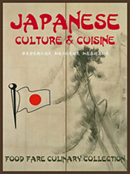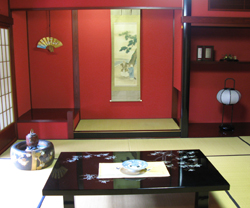|
Contents:
More:
|
Mealtime, Table Settings & Etiquette
A typical Japanese meal might include several courses. They are served in strict order, arranged centrally on a plate or in a bowl. A "Kaiseki-ryori" is a Japanese meal of many courses, and is usually served when entertaining guests with sake. The courses might include all or some of the following:
The most common arrangement is to set hors d'oeuvres in a deep bowl. The appetizer is laid out on a tray; the clear soup is ladled into a deep bowl; the raw fish is placed on a matted bowl; and the stewed seafood and vegetables are placed on a plate (as are the broiled fish, deep-fried food and pickled vegetables). The rest of the servings are placed in various-sized bowls. Of course, each setting is neat and precise and attractive to the eye as well as the palate. People in Japan typically eat three meals a day, with afternoon and late-night snacking being considered normal. Changing seasons are also demonstrated in various dishes, such as fiddlehead ferns and bamboo shoots in springtime, fresh fish served on a bed of pebbles in summer, salad with chrysanthemum petals in autumn and warming custards and bean curd casseroles in winter. There are typical sayings in Japan used during a meal. Start eating after you say: Itadakimasu ("I will receive"), and finish with Gochiso sama deshita ("Thank you for the feast"). Slurping is also acceptable when eating noodles or soups, but burping or blowing your nose is considered the height of bad manners. The Japanese traditionally eat sitting on the floor, under a low table. In a casual setting, men sit cross-legged while women perch on their knees, putting both legs to one side. However, if both genders are in a formal setting the proper way to sit is kneeling symmetrically. The most important guest at a meal sits in the honored seat (kamiza), which is usually located the furthest from the entrance to the room. The host, or the socially least important person (shimoza), is supposed to sit closest to the entrance of the room. The toast with sake is normally given at the beginning of the meal, when everyone is present. Guests are expected to take an actual sip of the sake, or at least pretend to do so even if they don't usually partake of alcoholic beverages. An oshibori is a small wet cloth provided to each guest at the start of the meal. It is heated before it is used. Kaishi is the Japanese equivalent of a paper napkin.
|


